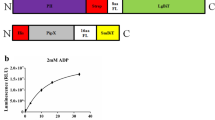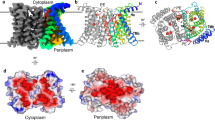Abstract
Changes of the pico- to nanomolar concentration of free intracellular Zn2+ are part of the signal transduction in mammalian cells. These zinc signals regulate the enzymatic activity of target proteins such as protein tyrosine phosphatases. For Escherichia coli, previous studies have reported diverging concentrations from femto- to picomolar, raising the question if Zn2+ could also have a function in bacterial signaling. This manuscript explores the use of the low molecular weight fluorescent probe Zinpyr-1 in E. coli. The probe detects free Zn2+ in these bacteria. Comparable to mammalian cells, other metal ions, especially Hg2+ and Cd2+, interfere with the detection of Zn2+. Moreover, experiments in E. coli were particularly prone to artifacts based on cellular autofluorescence, necessitating corrections that are not required in mammalian cells. Based on measurements in lysates of E. coli and the mammalian cell line Jurkat, similar values between 0.1 and 0.2 nM free Zn2+ were found. For E. coli, this corresponds to less than one free zinc ion per cell. Moreover, phosphatase inhibition by Zn2+ was only observed in Jurkat, but not E. coli. This excludes a function for zinc signals as a regulator of bacterial phosphatases. Still, changes in the free Zn2+ concentration were observed in response to elevated extracellular Zn2+ and pH, or to addition of the detergent NP-40, suggesting that other processes could be controlled by the free intracellular Zn2+ concentration.






Similar content being viewed by others
References
Bozym RA, Thompson RB, Stoddard AK, Fierke CA (2006) Measuring picomolar intracellular exchangeable zinc in PC-12 cells using a ratiometric fluorescence biosensor. ACS Chem Biol 1:103–111
Burdette SC, Walkup GK, Spingler B, Tsien RY, Lippard SJ (2001) Fluorescent sensors for Zn(2+) based on a fluorescein platform: synthesis, properties and intracellular distribution. J Am Chem Soc 123:7831–7841
Colvin RA, Holmes WR, Fontaine CP, Maret W (2010) Cytosolic zinc buffering and muffling: their role in intracellular zinc homeostasis. Metallomics 2:306–317
Cozzone AJ, Grangeasse C, Doublet P, Duclos B (2004) Protein phosphorylation on tyrosine in bacteria. Arch Microbiol 181:171–181
Decaria L, Bertini I, Williams RJ (2010) Zinc proteomes, phylogenetics and evolution. Metallomics 2:706–709
Deutscher J, Saier MH Jr (2005) Ser/Thr/Tyr protein phosphorylation in bacteria—for long time neglected, now well established. J Mol Microbiol Biotechnol 9:125–131
Gangola P, Rosen BP (1987) Maintenance of intracellular calcium in Escherichia coli. J Biol Chem 262:12570–12574
Grynkiewicz G, Poenie M, Tsien RY (1985) A new generation of Ca2+ indicators with greatly improved fluorescence properties. J Biol Chem 260:3440–3450
Haase H, Rink L (2009a) Functional significance of zinc-related signaling pathways in immune cells. Annu Rev Nutr 29:133–152
Haase H, Rink L (2009b) Immunotoxicology of cadmium. In: Parvau RG (ed) Cadmium in the environment. Nova publishers, New York
Haase H, Hebel S, Engelhardt G, Rink L (2006) Flow cytometric measurement of labile zinc in peripheral blood mononuclear cells. Anal Biochem 352:222–230
Haase H, Hebel S, Engelhardt G, Rink L (2009) Zinc ions cause the thimerosal-induced signal of fluorescent calcium probes in lymphocytes. Cell Calcium 45:185–191
Haase H, Ober-Blobaum JL, Engelhardt G, Hebel S, Rink L (2010) Cadmium ions induce monocytic production of tumor necrosis factor-alpha by inhibiting mitogen activated protein kinase dephosphorylation. Toxicol Lett 198:152–158
Haase H, Engelhardt G, Hebel S, Rink L (2011) Mercuric ions inhibit mitogen-activated protein kinase dephosphorylation by inducing reactive oxygen species. Toxicol Appl Pharmacol 250:78–86
Kobir A, Shi L, Boskovic A, Grangeasse C, Franjevic D, Mijakovic I (2011) Protein phosphorylation in bacterial signal transduction. Biochim Biophys Acta 1810:989–994
Krezel A, Maret W (2006) Zinc-buffering capacity of a eukaryotic cell at physiological pZn. J Biol Inorg Chem 11:1049–1062
Kubitschek HE, Friske JA (1986) Determination of bacterial cell volume with the coulter counter. J Bacteriol 168:1466–1467
Maret W (2011) Metals on the move: zinc ions in cellular regulation and in the coordination dynamics of zinc proteins. Biometals 24:411–418
Maret W (2012) Human zinc biochemistry. In: Rink L (ed) Zinc in human health. IOS press, Amsterdam, pp 45–62
Outten CE, O’Halloran TV (2001) Femtomolar sensitivity of metalloregulatory proteins controlling zinc homeostasis. Science 292:2488–2492
Rosenbluth MJ, Lam WA, Fletcher DA (2006) Force microscopy of nonadherent cells: a comparison of leukemia cell deformability. Biophys J 90:2994–3003
Thompson RB (2005) Studying zinc biology with fluorescence: ain’t we got fun? Curr Opin Chem Biol 9:526–532
Wang D, Hurst TK, Thompson RB, Fierke CA (2011) Genetically encoded ratiometric biosensors to measure intracellular exchangeable zinc in Escherichia coli. J Biomed Opt 16:087011
Wang D, Hosteen O, Fierke CA (2012) ZntR-mediated transcription of zntA responds to nanomolar intracellular free zinc. J Inorg Biochem 111:173–181
Author information
Authors and Affiliations
Corresponding author
Rights and permissions
About this article
Cite this article
Haase, H., Hebel, S., Engelhardt, G. et al. Application of Zinpyr-1 for the investigation of zinc signals in Escherichia coli . Biometals 26, 167–177 (2013). https://doi.org/10.1007/s10534-012-9604-0
Received:
Accepted:
Published:
Issue Date:
DOI: https://doi.org/10.1007/s10534-012-9604-0




